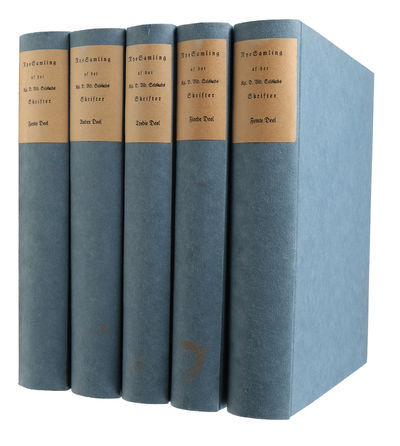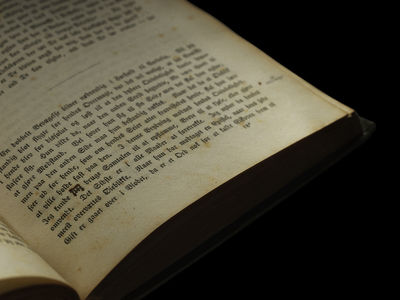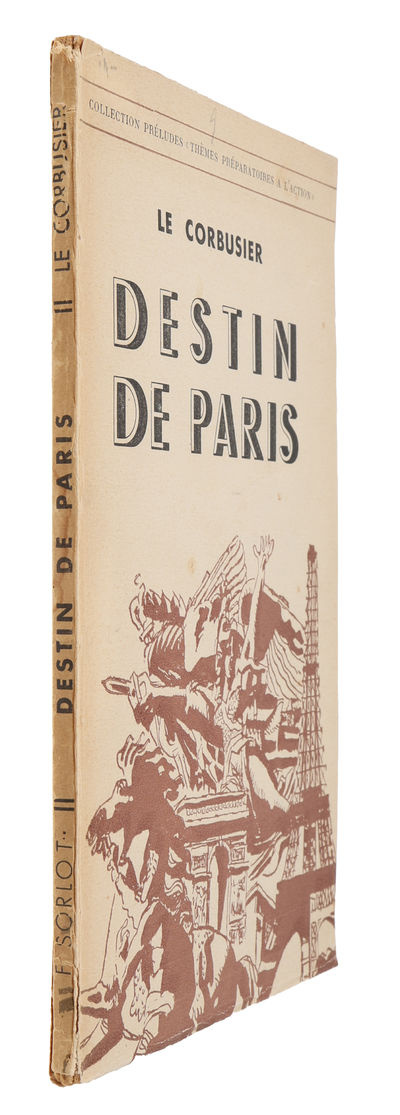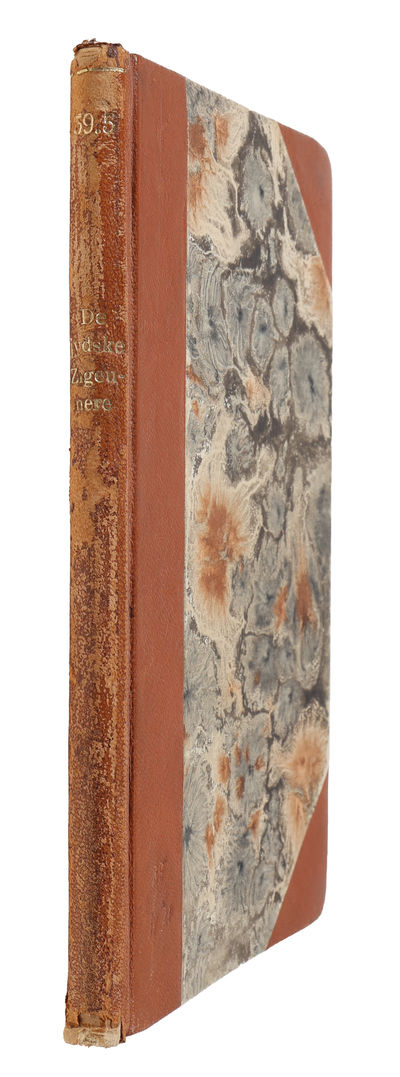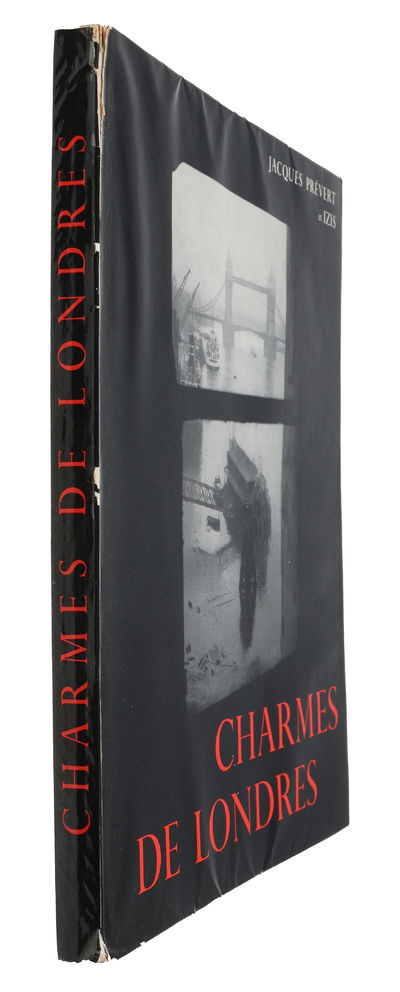KIERKEGAARD, SØREN.
Gjentagelsen. Et Forsøg i den experimenterende Psychologi af Constantin Constantius. - [KIERKEGAARD’S OWN COPY - ONE OF THE TWO COPIES HE HAD MADE FOR REGINE AND FOR HIMSELF]
Herman H. J. Lynge & Søn A/S
lyn62138
Kjøbenhavn, Reitzel, 1843. Small 8vo. 157 pp. Splendidly bound in beautiful patterned pink moiré-paper covered with red and green floriated gilt branches. Rebacked in nearly matching paper. Blue silk end-papers. All edges gilt. Printed on thick vellum-paper. A splendid copy with light edgewear and absolutely minimal brownspotting. Contemporary inscription to front fly-leaf stating that this is Kierkegaard’s own copy and that it was bought at the auction after him, April 1856 (presumably in the hand of Herman H.J. Lynge). Housed in a beautiful marbled paper box with red Morocco spine. Spine with gilt lines and gilt gothic lettering stating title, the pseudonymous author name and that this is Kierkegaard’s own copy printed on heavy vellum-paper.
Kierkegaard’s own copy of Repetition, one of the two copies he had printed on special paper and specially bound, one for Regine, one for himself, with a correction in Kierkegaard’s hand. This is as close as one comes to the love story of Regine and Kierkegaard – this is Kierkegaard’s own copy that he kept himself, from the love-set of the two copies of Repetition he had made, where the other was for Regine. One of the two copies of the book that he had made on special paper and bound in this particularly beautiful and romantic binding with gilding and flowers. Kierkegaard had his eight pseudonymous works made like this, one for Regine, one for himself. So far, only four of these have surfaced, Regine’s copies of Repetition, Prefaces, and Either-Or (all three sold at auction in 2002), and Kierkegaard’s own copy of Either-Or (which is in the Danish Royal Library). The other copies are unregistered, and the whereabouts unknown. The present copy is presumably that described merely as “dainty w. gilt edges”, nr. 2125 from the auction catalogue, which Herman H.L. Lynge bought at the auction. The correction is to be found on p. 80, where “legede” (played) has been changed to “levede” (lived). See Pap. IV B99. REPETITION – not only the title of one of his most significant books, but also a key concept in the philosophy of Kierkegaard – was written during the same brief spell of feverish activity that also produced Fear and Trembling; the two books were even published on the same day. ”Say what you will, this question will play a very important role in modern philosophy, for repetition is a crucial expression for what “recollection” was to the Greeks. Just as they taught that all knowing is a recollecting, modern philosophy will teach that all life is a repetition.” (Repetition, p. 3 – translation by Hong), Kierkegaard states in the beginning of his treatise, anticipating the importance that his concept of Repetition is to have for modern philosophy. Written in the narrative form of an experimental novel centered on two stories that are internally linked, Kierkegaard lets us understand what Repetition could be and what it is in his philosophy. The first story portrays Repetition as something empty and trivial, whereas the second portrays it as an ethical category that is inextricably linked to religion. Repetition is that which makes it possible for man to become and to remain present in the present. Kierkegaard’s explanation of his key concept of Repetition is exhausted in the present work, but it also plays a significant rôle throughout his later works and is considered one of the key concepts in his philosophy. The work is centered around the story of a young man, who has fallen in love with an innocent young girl to whom he has become engaged. But, finding himself unable to consummate the love because of poetic stirrings inside himself, he tries to understand what is going on inside him and whether or not he should break off the engagement. The elderly Constantin Constantius, one of Kierkegaard’s numerous pseudonyms, interferes with the emotions of our young man and begins to conduct speculative experiments with him that are meant to investigate whether a repetition (of the relationship with the girl, of the young man’s feelings, etc.) might be possible. At the end of the first part, the young man flees Copenhagen and leaves the girl, presumably at her wits’ end. Later, she marries someone else, and the young man transforms into the true poet that he could only be when unattached to the girl he loved. It does not take much of an imagination to link this story to the Kierkegaard’s own wildly famous love story and failed engagement to Regine Olsen. It all begins in 1837, when Kierkegaard meets the lovely young girl Regine Olsen at a visit to the widowed Cathrine Rørdam. Three years later, in September 1840, after having corresponded frequently with her and visited her on numerous occasions, Kierkegaard decides to ask for her hand in marriage. She and her family accept, but the following day, Kierkegaard regrets his decision and ends up finally breaking off the engagement in October 1841. Disregarding the scandal, the heartbreak (his own included), and the numerous pleas from family members and friends alike, Kierkegaard’s tortured soul, still searching for God and for the meaning of faith, cannot continue living with the promise of marriage. Later the same month, he flees Copenhagen and the scandal surrounding the broken engagement. He leaves for Berlin, the first of his four stays there, clearly tortured by his decision, but also intent on not being able to go through with the engagement. As is evident from his posthumously published Papers, Kierkegaard’s only way out of the relationship was to play a charming, but cold, villain, a charlatan, not betraying his inner thoughts and feelings. Despite the brevity of the engagement, it has gone down in history as one of the most significant in the entire history of modern thought. It is a real-life Werther-story with the father of Existentialism as the main character, thus with the dumbfounding existentialist outcome that no-one could have foreseen. This exceedingly famous and difficult engagement became the introduction to one of the most influential authorships in the last two centuries. “She was the reason for my authorship”, Kierkegaard writes in his Papers, and there is no doubt that several of his most significant works are born out of the relationship with Regine – and its ending. It is during his stay in Berlin, his first of four altogether, right after the rupture of the engagement, that he begins writing Either-Or, parts of which, like Repetition, can be read as an almost autobiographical rendering of his failed engagement. Repetition, more than any other work, lets us see how Kierkegaard came to be as an author through his tumultuous inner life during his engagement and the ending of it. After a couple of years, Regine got engaged to someone else, whom she married in 1847. But as is well known, Kierkegaard never married, and the impact of his engagement to Regine and what it made him understand – about himself, about religion, faith, the inner workings of the philosopher and the poet –, never lost its significance. It is evident from the many drafts of a letter that he sent to Regine, through her husband, in 1849 (which was returned to him, unopened) that he had never lain the matter to rest and that the relationship with Regine was still very much alive. He also states in his Notebook 15 from 1849 “By the way, it is certainly the case that my relationship with her has been a very close, present study for me of what faith is. For I know better in this relationship how it is apparently the exact opposite of the foundational. That I have lasted in this relationship has been useful for me in relating to God as a believer.” In his Notebook 15, also known as My Relationship with Her, from 1849, Kierkegaard describes how, when he finally broke off the engagement and she tried to get him to stay, she had told him “that she would thank me her entire life for being allowed to stay with me, even if she were to live in a little cupboard” (SKS No. 16: 6). Thus, Kierkegaard had a little cupboard made, with no shelves in it. Here, he kept “everything that reminds me of her and will remind me of her. There is also a copy of the pseudonyms (i.e. the works that he wrote under a pseudonym); of these, there were always only two copies on vellum-paper, one for her and one for me.” (SKS: Not. 15:6.). Here we have it – the closest we get to this pivotal love affair from which grew one of the most important philosophical-religious authorships in the Western world. In all, Kierkegaard wrote eight pseudonymous books, Repetition being one of them, all of which were evidently printed in two copies each on vellum-paper and bound in special bindings, one for Regine, one for Kierkegaard himself. 24 years ago, three of these books surfaced, at an auction in 2002, namely Either-Or, Repetiton, and Prefaces, all being the copies Kierkegaard had bound for Regine. Before that, only one single copy of one of these eight titles for Kierkegaard himself or for Regine were known (namely Kierkegaard’s own copy of Either-Or, which is in the Danish Royal Library). Seven of the books, Kierkegaard’s own copies, were listed in the auction catalogue after his death, but apart from the mentioned copy of Either-Or in the Royal Library, the others had not been found. The four known copies are all bound in very particular, beautiful, patterned bindings with flowers and gold, in either pink or white. Like Fear and Trembling, there are no presentation-copies known to exist of Repetition. Himmelstrup 53
Kierkegaard’s own copy of Repetition, one of the two copies he had printed on special paper and specially bound, one for Regine, one for himself, with a correction in Kierkegaard’s hand. This is as close as one comes to the love story of Regine and Kierkegaard – this is Kierkegaard’s own copy that he kept himself, from the love-set of the two copies of Repetition he had made, where the other was for Regine. One of the two copies of the book that he had made on special paper and bound in this particularly beautiful and romantic binding with gilding and flowers. Kierkegaard had his eight pseudonymous works made like this, one for Regine, one for himself. So far, only four of these have surfaced, Regine’s copies of Repetition, Prefaces, and Either-Or (all three sold at auction in 2002), and Kierkegaard’s own copy of Either-Or (which is in the Danish Royal Library). The other copies are unregistered, and the whereabouts unknown. The present copy is presumably that described merely as “dainty w. gilt edges”, nr. 2125 from the auction catalogue, which Herman H.L. Lynge bought at the auction. The correction is to be found on p. 80, where “legede” (played) has been changed to “levede” (lived). See Pap. IV B99. REPETITION – not only the title of one of his most significant books, but also a key concept in the philosophy of Kierkegaard – was written during the same brief spell of feverish activity that also produced Fear and Trembling; the two books were even published on the same day. ”Say what you will, this question will play a very important role in modern philosophy, for repetition is a crucial expression for what “recollection” was to the Greeks. Just as they taught that all knowing is a recollecting, modern philosophy will teach that all life is a repetition.” (Repetition, p. 3 – translation by Hong), Kierkegaard states in the beginning of his treatise, anticipating the importance that his concept of Repetition is to have for modern philosophy. Written in the narrative form of an experimental novel centered on two stories that are internally linked, Kierkegaard lets us understand what Repetition could be and what it is in his philosophy. The first story portrays Repetition as something empty and trivial, whereas the second portrays it as an ethical category that is inextricably linked to religion. Repetition is that which makes it possible for man to become and to remain present in the present. Kierkegaard’s explanation of his key concept of Repetition is exhausted in the present work, but it also plays a significant rôle throughout his later works and is considered one of the key concepts in his philosophy. The work is centered around the story of a young man, who has fallen in love with an innocent young girl to whom he has become engaged. But, finding himself unable to consummate the love because of poetic stirrings inside himself, he tries to understand what is going on inside him and whether or not he should break off the engagement. The elderly Constantin Constantius, one of Kierkegaard’s numerous pseudonyms, interferes with the emotions of our young man and begins to conduct speculative experiments with him that are meant to investigate whether a repetition (of the relationship with the girl, of the young man’s feelings, etc.) might be possible. At the end of the first part, the young man flees Copenhagen and leaves the girl, presumably at her wits’ end. Later, she marries someone else, and the young man transforms into the true poet that he could only be when unattached to the girl he loved. It does not take much of an imagination to link this story to the Kierkegaard’s own wildly famous love story and failed engagement to Regine Olsen. It all begins in 1837, when Kierkegaard meets the lovely young girl Regine Olsen at a visit to the widowed Cathrine Rørdam. Three years later, in September 1840, after having corresponded frequently with her and visited her on numerous occasions, Kierkegaard decides to ask for her hand in marriage. She and her family accept, but the following day, Kierkegaard regrets his decision and ends up finally breaking off the engagement in October 1841. Disregarding the scandal, the heartbreak (his own included), and the numerous pleas from family members and friends alike, Kierkegaard’s tortured soul, still searching for God and for the meaning of faith, cannot continue living with the promise of marriage. Later the same month, he flees Copenhagen and the scandal surrounding the broken engagement. He leaves for Berlin, the first of his four stays there, clearly tortured by his decision, but also intent on not being able to go through with the engagement. As is evident from his posthumously published Papers, Kierkegaard’s only way out of the relationship was to play a charming, but cold, villain, a charlatan, not betraying his inner thoughts and feelings. Despite the brevity of the engagement, it has gone down in history as one of the most significant in the entire history of modern thought. It is a real-life Werther-story with the father of Existentialism as the main character, thus with the dumbfounding existentialist outcome that no-one could have foreseen. This exceedingly famous and difficult engagement became the introduction to one of the most influential authorships in the last two centuries. “She was the reason for my authorship”, Kierkegaard writes in his Papers, and there is no doubt that several of his most significant works are born out of the relationship with Regine – and its ending. It is during his stay in Berlin, his first of four altogether, right after the rupture of the engagement, that he begins writing Either-Or, parts of which, like Repetition, can be read as an almost autobiographical rendering of his failed engagement. Repetition, more than any other work, lets us see how Kierkegaard came to be as an author through his tumultuous inner life during his engagement and the ending of it. After a couple of years, Regine got engaged to someone else, whom she married in 1847. But as is well known, Kierkegaard never married, and the impact of his engagement to Regine and what it made him understand – about himself, about religion, faith, the inner workings of the philosopher and the poet –, never lost its significance. It is evident from the many drafts of a letter that he sent to Regine, through her husband, in 1849 (which was returned to him, unopened) that he had never lain the matter to rest and that the relationship with Regine was still very much alive. He also states in his Notebook 15 from 1849 “By the way, it is certainly the case that my relationship with her has been a very close, present study for me of what faith is. For I know better in this relationship how it is apparently the exact opposite of the foundational. That I have lasted in this relationship has been useful for me in relating to God as a believer.” In his Notebook 15, also known as My Relationship with Her, from 1849, Kierkegaard describes how, when he finally broke off the engagement and she tried to get him to stay, she had told him “that she would thank me her entire life for being allowed to stay with me, even if she were to live in a little cupboard” (SKS No. 16: 6). Thus, Kierkegaard had a little cupboard made, with no shelves in it. Here, he kept “everything that reminds me of her and will remind me of her. There is also a copy of the pseudonyms (i.e. the works that he wrote under a pseudonym); of these, there were always only two copies on vellum-paper, one for her and one for me.” (SKS: Not. 15:6.). Here we have it – the closest we get to this pivotal love affair from which grew one of the most important philosophical-religious authorships in the Western world. In all, Kierkegaard wrote eight pseudonymous books, Repetition being one of them, all of which were evidently printed in two copies each on vellum-paper and bound in special bindings, one for Regine, one for Kierkegaard himself. 24 years ago, three of these books surfaced, at an auction in 2002, namely Either-Or, Repetiton, and Prefaces, all being the copies Kierkegaard had bound for Regine. Before that, only one single copy of one of these eight titles for Kierkegaard himself or for Regine were known (namely Kierkegaard’s own copy of Either-Or, which is in the Danish Royal Library). Seven of the books, Kierkegaard’s own copies, were listed in the auction catalogue after his death, but apart from the mentioned copy of Either-Or in the Royal Library, the others had not been found. The four known copies are all bound in very particular, beautiful, patterned bindings with flowers and gold, in either pink or white. Like Fear and Trembling, there are no presentation-copies known to exist of Repetition. Himmelstrup 53
Address:
Silkegade 11
DK-1113 Copenhagen Denmark
Phone:
CVR/VAT:
DK 16 89 50 16
Email:
Web:
![Gjentagelsen. Et Forsøg i den experimenterende Psychologi af Constantin Constantius. - [KIERKEGAARD’S OWN COPY - ONE OF THE TWO COPIES HE HAD MADE FOR REGINE AND FOR HIMSELF] (photo 1)](https://d3525k1ryd2155.cloudfront.net/h/721/685/1714685721.0.l.jpg)
![Gjentagelsen. Et Forsøg i den experimenterende Psychologi af Constantin Constantius. - [KIERKEGAARD’S OWN COPY - ONE OF THE TWO COPIES HE HAD MADE FOR REGINE AND FOR HIMSELF] (photo 2)](https://d3525k1ryd2155.cloudfront.net/h/721/685/1714685721.1.l.jpg)
![Gjentagelsen. Et Forsøg i den experimenterende Psychologi af Constantin Constantius. - [KIERKEGAARD’S OWN COPY - ONE OF THE TWO COPIES HE HAD MADE FOR REGINE AND FOR HIMSELF] (photo 3)](https://d3525k1ryd2155.cloudfront.net/h/721/685/1714685721.2.l.jpg)
![Gjentagelsen. Et Forsøg i den experimenterende Psychologi af Constantin Constantius. - [KIERKEGAARD’S OWN COPY - ONE OF THE TWO COPIES HE HAD MADE FOR REGINE AND FOR HIMSELF] (photo 4)](https://d3525k1ryd2155.cloudfront.net/h/721/685/1714685721.3.l.jpg)
![Gjentagelsen. Et Forsøg i den experimenterende Psychologi af Constantin Constantius. - [KIERKEGAARD’S OWN COPY - ONE OF THE TWO COPIES HE HAD MADE FOR REGINE AND FOR HIMSELF] (photo 5)](https://d3525k1ryd2155.cloudfront.net/h/721/685/1714685721.4.l.jpg)
